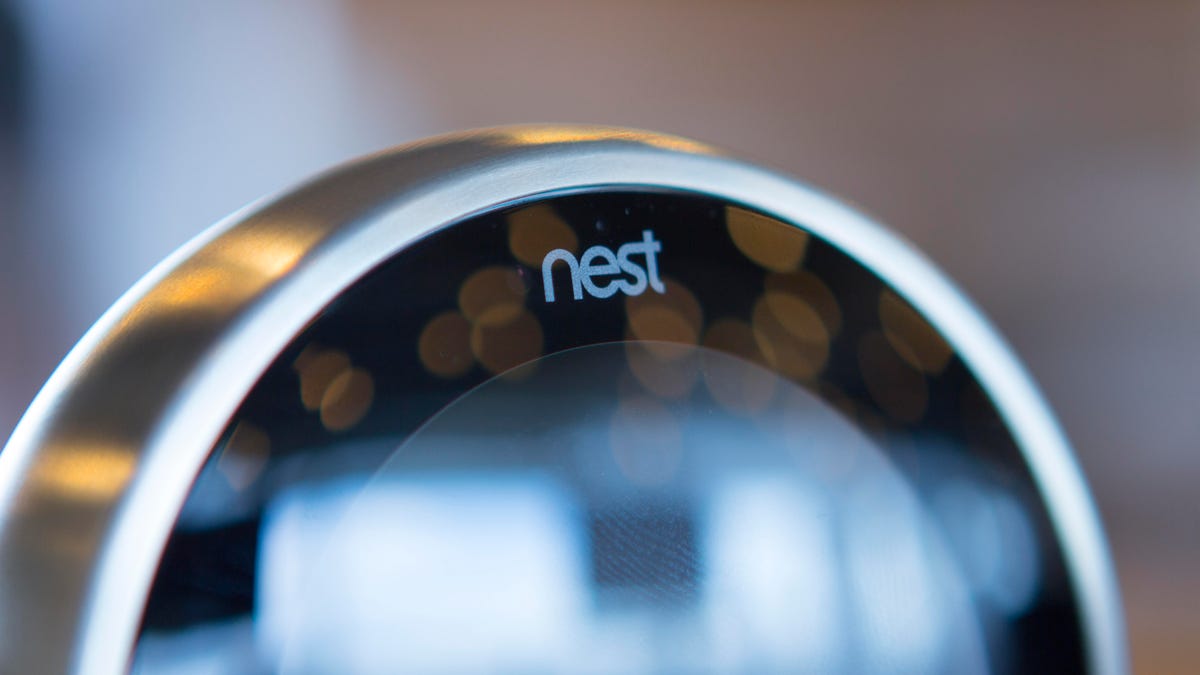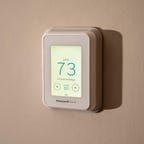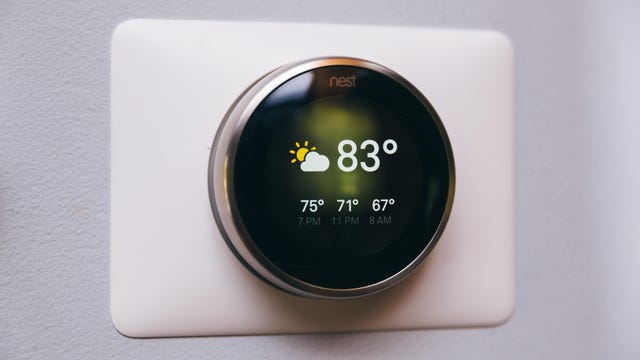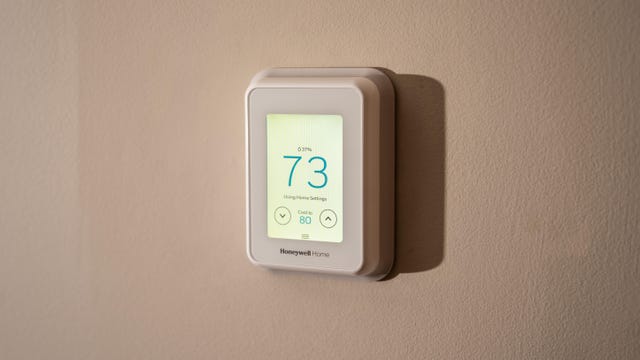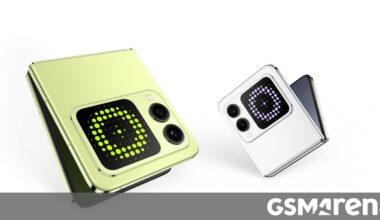In this article:
What is the best smart thermostat?
I lead CNET’s home energy coverage and find people often seek technology that helps solve a problem. Earlier this year, I predicted 2024 to be the year we take control of our home’s energy and a smart thermostat is one tool to help you get there.
And not to overlook, but most people want to save money or take control of their energy consumption. A recent CNET survey found that 20% of US adults plan to use a smart thermostat to help reduce their home’s energy costs.
We believe the best smart thermostat is one with enough intelligence to help you better control your comfort and energy bills while being at a price low enough not to eat up those savings. So, after spending years tinkering with thermostats considering their features, apps, connectivity and user-friendliness — and other home energy products, I found the Amazon Smart Thermostat to be the best overall smart thermostat — among all the smart thermostats that we tested — based on its features and affordability.
Amazon’s smart thermostat leans heavily on the company’s Alexa technology, packing features you’d normally find in a product costing far more than its $80 price tag. Its inclusion of helpful tips helps you improve other aspects of your home’s efficiency. But its competition is not far behind. Here are the best smart thermostats in 2024.
Best smart thermostats of 2024
Most of the features of a high-end smart thermostat at a fraction of the price. The Amazon Smart Thermostat stands out among its peers in the sub-$100 category by having far better technology, including the ability to sense if you’re home and Alexa’s “hunches” to see if a setting will work while saving you energy. It doesn’t have quite the advanced features of a $200 thermostat and its display is fairly basic, but are those worth $120 or more? Another thing I liked: It shows information about your energy and HVAC usage, with explanations about what it all means — a smart thermostat that makes the user smarter.
Read our Amazon Smart Thermostat review.
One of the selling points of a smart thermostat is that it can save you money, so we can’t say money is no object. But if money were no object, the Ecobee Smart Thermostat Premium would eclipse the competition. It offers the most advanced features, from sensors that track indoor air quality, the ability to show a four-day forecast on the thermostat itself, a virtual assistant that helps with scheduling and an included external room sensor to help keep your whole home comfortable. Plus it doubles as a Bluetooth speaker, which is by no means a necessity for a thermostat but is cool nonetheless.
Read our Ecobee Smart Thermostat Premium review.
The Sensi Touch 2 is an excellent choice if you’re the kind of person who interacts with the physical thermostat a lot. The app is good and the thermostat is compatible with Alexa and Google Home, but the display on this one really shines. It’s simple, intuitive and clear and allows you to make changes easily. Some other thermostats require you to know what the particular icon means, which can add to the learning curve, but this one is easy and straightforward. Plus the temperature setting is prominently displayed and you can set a range of temperatures very easily with the tap of a finger.
The Nest Learning Thermostat can sense when you’re home or not, trains you to find settings that use less energy and does all of the other things you’d expect from a high-end smart thermostat. The Nest Learning Thermostat will function with or without a C-wire, making it easier to install if you’re a renter or if you’re squeamish about doing too much wiring.
The Honeywell Home T9 is like a smart thermostat with the soul of a traditional thermostat. You don’t have to open up the app to install it and get it running, and the instructions are excellent. The device’s interface is clean and easy to understand, as is the app. It also comes with an external room sensor, and you can set the temperature to target a specific room or to even the temperature out throughout the house.
Read our Resideo Honeywell Home T9 Smart Thermostat review.
Factors to consider when choosing a smart thermostat
When you’re shopping for a traditional standard thermostat, there isn’t much to consider. What does it look like? Can you program it? Does it have that cool old-fashioned dial?
When shopping for a smart thermostat, there are a lot more options and some things one person may love while the next person may hate. Here’s what we think is important to consider.
Smart home integration
Smart thermostats all come with some kind of app or option to control the device from your phone. If you have a particular affinity for one smart home family or another, you’ll want to make sure you’re getting a thermostat that will work in conjunction with your other devices. Most smart thermostats will take voice commands from Amazon’s Alexa, but if the rest of your home is running on, say, Apple’s HomeKit, not every device will provide support.
Make sure you’re getting something that will play nice with the rest of your smart home.
Geofencing
For the most part, your thermostat’s job is to keep your home comfortable for you. That means you don’t necessarily need it to be the perfect temperature when you aren’t home. Many smart thermostats feature geofencing, meaning they can track whether or not you’re home and set their expectations accordingly.
Some devices track occupancy based on the phones of those in the household, while others combine that feature with other occupancy sensors. The good thing is that you can set limits around this feature: Do you want it to change the temperature when you’re away? How far away do you have to be for it to kick in? What temperature limits should there be if you aren’t home? The latter is important if you have pets. You don’t want the cats sweltering or freezing while you’re at work.
How smart do you want your thermostat to be?
Everyone wants a different level of control over their thermostat. Some people want to decide at every moment what the temperature should be. (In that case, you can also consider a basic Wi-Fi-enabled programmable thermostat like the Honeywell Home RTH6580WF, which doesn’t have as many smart features as its more expensive peers but can be adjusted from your phone.)
Some smart thermostats can be too smart for their own good. One of the most common complaints I’ve heard is that some products will hold the temperature you set them to only for a little bit, and then they’ll revert to what the thermostat believes the temperature should be. If that would annoy you, focus on the ones that offer you the most control like the Honeywell Home T9 Smart Thermostat.
Installation
Not all thermostats are installed exactly the same way, but they’re all pretty similar. Expect to need a screwdriver, a pair of pliers capable of moving wires around and potentially a drill and a level. Installation is pretty simple once you’ve done it once or twice: Turn off the power, mark the wires, take off the old one, wire the new one, and put the thermostat up. There is one potential complication you’ll want to watch out for: Does your system have a C-wire?
There are usually five or so wires that come out of your wall to connect a thermostat. The older wires tend to carry just enough electricity to power an old-school thermostat. Smarter devices, which can tell you the weather or maybe play your playlist and need an internet connection, need more power than that. This is achieved through a C-wire, designed to carry more electricity to the thermostat. Not every home is wired with one, but if you don’t have one, you have a couple of choices.
First is to get a thermostat that doesn’t require a C-wire. This is where the Nest thermostats are set apart, because they’re capable of charging their batteries off of the other wires. Although some customer reviews report short-cycling and other issues, so keep an eye on it.
The second option is to install an adapter kit. This involves adding a device at your HVAC system that converts one of the existing wires into a C-wire. Fortunately, most of the smart thermostats we’ve looked at that require a C-wire come with these kits. If not, you can pick one up for something like $25.
External sensors
Your thermostat knows what the temperature is because it has a thermometer inside of it. The device’s understanding of the temperature inside is usually limited to the temperature exactly where you mounted it to the wall. What about that stuffy bedroom?
Many smart thermostats come with or are at least able to connect to separate room sensors. These room sensors allow you to train the thermostat to keep your house as comfortable as possible throughout the home. With external sensors, thermostats can target an individual room and get it to a comfortable temperature at a certain time (the bedroom at night, the home office during the day, etc.) or to find a setting that makes everywhere as comfortable as possible, not just the room with the thermostat in it. Some even have proximity sensors in their room sensors, meaning they can tell when a room is occupied or not.
How we test smart thermostats
Most of the home energy products we test and evaluate here at CNET have a lot of numbers attached to them: the efficiency of solar panels and the power output of batteries. Not so with smart thermostats. All of these thermostats can perform the basic functions of turning your heater on when it’s cold and your AC on when it’s hot. While some of our scoring is based on tangible, mathematical data, it’s mostly about the myriad ways you can interact with the thermostat to get the comfort level and energy savings you want.
We’ve experimented, tested and handled each of the thermostats mentioned on this list, including installing them on a testing rig that simulates a standard HVAC system, programming them and trying their various features. Insert pic of the testing rig

We used this rig, built by our CNET Labs engineers, to hook up a variety of thermostats to test their interfaces and apps.
The 10-point scores we give smart thermostats are based on these metrics:
- 15% is an average of customer ratings from Amazon, Google, Home Depot and Best Buy, if available. Our hands-on experience with the thermostat is just one data point, and we want to see how consumers whose homes and systems vary experienced these devices.
- 15% is based on the available smart home connectivity and other features, including geofencing and external room sensors.
- 20% is the price, with a formula that rewards less expensive products.
- 50% is completely subjective, based on our assessment of what the device offers, how easy it is to install, how easy the app or interface is to use and what features it has that might be non-standard for thermostats but helpful or useful for consumers.
Choosing a thermostat is an incredibly subjective and personal choice, and our goal in scoring is to highlight those products that do the most and do them well. Your buying decision should focus on your priorities, which might not align exactly with ours, so be sure to look at more than just a score when choosing a device you will probably interact with almost every day.
Other smart thermostats we’ve tested
Commercial Electric Smart Thermostat: Despite the name, this new offering from The Home Depot is in fact a residential thermostat built to operate with the company’s Hubspace smart home platform, although it’ll work with Alexa and Google Home. It’s a fairly straightforward system allowing significant control but lacking in truly smart features. My favorite feature: Being able to set a schedule based on sunrise or sunset.
Cync Smart Thermostat: This thermostat from GE Lighting, now owned by Savant which offers other home energy products such as solar batteries, offers good smart home interactions and the ability to buy an external sensor, but it lacked some of the more advanced features offered by other thermostats, while still costing more than the Amazon model.
Nest Thermostat: The Nest Thermostat was a compelling choice at a mid-level price range ($130), but a few things held it back. For one, it lacks the intuitive interface and features of its smarter big sibling (the Nest Learning Thermostat), and it wants to use the Google Home app instead of the more intuitive and feature-rich Nest app used by the Learning model. The installation prompts send you straight into scheduling, so prepare yourself for that.
Smart thermostat FAQ
How do I install a smart thermostat?
If you’ve ever installed a thermostat before, you can install a smart thermostat (provided your home has the right wiring). Every smart thermostat comes with installation instructions, whether in a printed pamphlet, on an app, or both. Essentially, the directions all boil down to:
- Shut off the circuit for your HVAC system and make sure the power is off by trying to turn the heat or air on.
- Remove your old thermostat, leaving the wires attached.
- Label the wires and/or take a picture of them so you know which is which.
- Disconnect the wires from your old thermostat.
- Prepare the back plate of the new thermostat and the wall plate, which can cover up the area around the thermostat installation, if you’re using it.
- Insert the wires into the back plate as the new thermostat directs.
- Mount the plates, attach the thermostat and turn the power back on.
Are smart thermostats really worth it?
They can be. A smart thermostat, if used correctly, can minimize your use of energy by running your HVAC system only when necessary. It might also be worth it by enabling you to have more control over the temperature in your home, including adjusting the temperature from your phone or by voice command.
Can a smart thermostat save you money?
That depends on how much energy it actually saves. If the smart thermostat results in you using less energy to heat and cool your home, that’s savings. Considering heating and cooling is by far the biggest use of energy in American homes, the savings could be significant. You can also save money by participating in programs like a virtual power plant, which could give you credits in exchange for a little bit of control when the grid needs it. If your energy habits don’t change, you might just have a more expensive gadget to go with the same energy bills.
What do you need to know before you buy a smart thermostat?
The most important thing you need to know is why you’d get one and what your goals would be. A smart thermostat can be a valuable tool, but if you’re just going to turn the dial on it to change the temperature, it might not be worth it. Make sure you know what you’re looking to get out of it, whether that’s energy savings, smart home integration or just a better understanding of your energy consumption.
You also need to know whether your HVAC system is compatible with the thermostat you want. Most manufacturers have a guide to see if it will work. The third thing: Know if your HVAC system has a C-wire installed, although that’s not necessarily a deal-breaker.
Who should purchase a smart thermostat?
If you’re looking to take more control over your energy use, a smart thermostat could be a big part of that. You should also consider one if you hate having to change the temperature setting often, or if you frequently need to do so from the other side of the house.
What about privacy and security?
As with anything “smart” these days, there are some risks and concerns about the privacy and security of the information these devices collect and share. Consider the company’s data collection and sharing policies and weigh them against your personal preferences. If you’re worried about data collection, a Wi-Fi-enabled thermostat that isn’t smart might be a better fit.
Can I get a smart thermostat if I don’t have a C-wire?
You can. There are a couple of ways to go about it. One is to install a C-wire adapter, which many smart thermostats come with. This will require some wiring work at the HVAC unit, but it will allow you to run a smart thermostat.
Aside from that option, there are some smart thermostats that can run without a C-wire: the Nest products. Of these, the Nest Learning Thermostat, while pricier, was one of our favorites.
